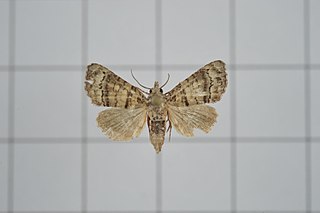Streblote dorsalis is a moth of the family Lasiocampidae first described by Francis Walker in 1866. It is found in India, Sri Lanka, the Philippines, Borneo, Indonesia and Java.

Caduca albopunctata is a moth of the family Noctuidae first described by Francis Walker in 1857.
Anomis combinans, the yellow-banded semi-looper moth, is a moth of the family Erebidae. The species was first described by Francis Walker in 1858. It is found in Australia, Sri Lanka, Borneo, New Guinea, Malaysia and Timor.
Dysaethria conflictaria, or Epiplema conflictaria, is a moth of the family Uraniidae first described by Francis Walker in 1861. It is found in Indo-Australian tropics of India, Sri Lanka, Thailand, Papua New Guinea, the Solomon Islands and Australia.

Phazaca erosioides is a moth of the family Uraniidae first described by Francis Walker in 1863. It is found in the Indo-Australian tropics from Sri Lanka to New Guinea.
Stictoptera trajiciens is a moth of the family Euteliidae first described by Francis Walker in 1857. It is found in Oriental tropics of Sri Lanka, to Sundaland, the Philippines, Sulawesi and New Guinea.
Avitta ophiusalis is a moth of the family Noctuidae first described by Francis Walker in 1859. It is found in Indian subregion, Sri Lanka, China, Japan, Sundaland, Sulawesi, Queensland, Solomon Islands, Vanuatu, Fiji and New Caledonia.
Avitta rufifrons is a moth of the family Noctuidae first described by Frederic Moore in 1887. It is found in the Indian subregion, Sri Lanka, New Guinea, and Queensland, Australia.

Chlumetia transversa, the mango shoot borer, is a moth of the family Euteliidae. The species was first described by Francis Walker in 1863. It is a widely distributed across Indo-Australian tropical countries far east to Solomon Islands.
Callopistria thalpophiloides is a moth of the family Noctuidae first described by Francis Walker in 1862. It is found in the Indian subregion, Sri Lanka, Sundaland, China, Taiwan, Philippines, Sulawesi and New Guinea.

Rivula aequalis is a moth of the family Erebidae first described by Francis Walker in 1863. It is found in Sri Lanka, the Indian subregion, Japan, Sundaland, the Philippines and Sulawesi.
Aquis orbicularis is a moth of the family Nolidae first described by Francis Walker in 1858. It is found in the Indian subregion, Sri Lanka, Peninsular Malaysia, Papua New Guinea and Borneo.
Giaura tortricoides is a moth of the family Nolidae first described by Francis Walker in 1865. It is found in Sri Lanka, Japan, Andaman Islands, Borneo, Sumatra, Flores, Sulawesi, New Guinea, Bismarck Islands and Australia.

Maceda mansueta is a moth of the family Nolidae first described by Francis Walker in 1857. It is found in Japan, Sri Lanka, Borneo, India (Andamans), Malaysia, New Guinea, Fiji, Australia, Réunion and the Seychelles.

Maurilia iconica is a moth of the family Nolidae first described by Francis Walker in 1857. It is found in Indo-Australian tropics of Sri Lanka, Australia to the islands of Samoa, Rarotonga and New Caledonia.
Nycteola indicatana is a moth of the family Nolidae first described by Francis Walker in 1863. It is found in the Indian subregion, Sri Lanka, Singapore, Borneo, Java and the Solomon Islands.

Paracrama dulcissima is a moth of the family Nolidae first described by Francis Walker in 1864. It is found in Indo-Australian tropics of India, Sri Lanka and the Bismarck Islands.
Lasiolopha saturata is a moth of the family Nolidae first described by Francis Walker in 1865. It is found in Oriental tropics of India, Sri Lanka, Thailand, New Guinea and Australia.

Earias cupreoviridis, called the cupreous bollworm as a larva, is a moth of the family Nolidae. The species was first described by Francis Walker in 1862. It is found in African countries like Botswana, the Democratic Republic of the Congo, Eritrea, Ethiopia, the Gambia, Kenya, Nigeria, Sierra Leone, South Africa, Togo, Uganda, Zimbabwe to Asian countries like India, Sri Lanka, China, Japan, Korea, Philippines, Indonesia and Hong Kong.

Xenochroa chlorostigma is a moth of the family Nolidae first described by George Hampson in 1893. It is found in India, Sri Lanka, Himalaya, Sundaland, Philippines and Sulawesi.








